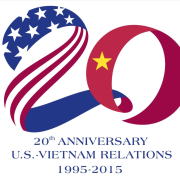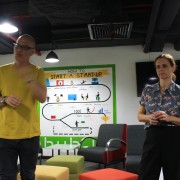Forty Years Later
This week we are at the end of a six-day holiday: Hung Vuong Day (Hung Vuong, i.e., “Hung King” is to celebrate the history and lineage of Vietnamese kings.) on April 28; Reunification Day (also called Victory Day or Liberation Day in Vietnam) on April 30; and International Worker’s Day on May 1, also known as “May Day.” It’s the first big holiday break since the Tet holiday (Lunar New Year, a nine-day holiday) back in February. (Originally, the current holiday vacation was requested to be eight days, but only six days were granted.) Signage proclaiming and celebrating these three special days are all over Hanoi, citizens have their flags out in front of their homes, and nationalist songs are broadcast on public address systems in the streets. During significant year anniversaries (30th, 35th, 40th, etc.) parades are held in Ho Chi Minh City to celebrate the north “releasing” the south and the veterans that led the way.
In general, the atmosphere in Vietnam is quieter between Christmas and the Lunar New Year (one-to-two months). Things pick up between the Lunar New Year and this current holiday, but slow down again as we enter this break—in effect, another “reset.” The last day before the holiday, April 27, was the deadline to push through agreements before the exodus to places like Ha Long Bay, Co To, and Cat Ba islands.
As with Tet, many workers return to their home provinces and the streets in major cities become a bit quieter with less traffic (and less honking but not less dangerous, unfortunately). However, some work still goes on: directly and anecdotally, some construction workers on residential projects, service workers in cafes and bars, and factory workers in Bac Ninh all maintained their posts. The next big holiday is in September when Vietnam celebrates its Independence day on September 2. Thus, there are four solid months where business can proceed, unimpeded by long stretches of holiday. At the same time, Ho Chi Minh City’s rainy season begins, which can slow down travel around town due to flooding, and the weather in Hanoi heats up considerably (also slowing down the pace of things) since the city experiences proper seasons without snow.
This year is the 40th anniversary of Reunification Day, when North Vietnamese forces (NVA) captured Saigon and the Second Indochina War ended. In the US, April 30, 1975 is largely viewed as the final day of a tragic chapter in American foreign policy in Vietnam. For the more than one million Viet-Kieu (and their children) in the US, every April brings renewed memories of hardship, sacrifice, loss—and perseverance in a new land. There is no doubt that the war was a dark period for relations between the two governments at great expense of its peoples, some of which continues today. However, more than 40 years after Operation Frequent Wind, Vietnamese attitudes toward the US and capitalism may raise a few eyebrows.
New Attitudes
According to Pew Research, 76% of Vietnamese expressed a favorable opinion of the US during a 2014 poll. Almost nine-in-ten young people (as well as more educated people) were fond of the US. Of those who lived through the Second Indochina War (the Vietnam War as it is called in the US), six-in-ten over the age of 50 held a favorable view of the US. Perhaps the most surprising figure from the poll was that 95% of Vietnamese respondents believe “that people are better off in a free market economy, even if some people are rich and some are poor.” That’s not a typo; ninety-five percent of Vietnamese believe that people are better off in a free market economy (perhaps because the poll respondents picture themselves as the rich ones).
In fact, it’s not uncommon to hear from successful Vietnamese (with direct or close relations to VVIPs) that “making money is not bad… as long as you don’t hurt anybody.” Now, for those who have not spent much time in Vietnam, it may be surprising that there are so many “pro-American” attitudes in a one-party state, especially in the capital.
But spend some time working with Saigonese and doing business with Hanoians and the Pew Research results aren’t that hard to believe at all. For one, Vietnamese love and voraciously consume American culture. Furious 7, Avengers: Age of Ultron, Jurassic World, and Terminator Genisys are all films that have been screened or will be screened in Vietnam. Along with KPOP, Vietnamese youth listen to a variety of American music artists such as Taylor Swift, Bruno Mars, Maroon 5, and Katy Perry. American flag backpacks (as a fashion statement) are an occasional sight in the streets of Ho Chi Minh City (formerly and still known as Saigon). Last autumn in Hanoi there was even a American-style prom organized and American-style wedding requests aren’t that uncommon. (In fact there is even an American ordained minister who has performed a ceremonial wedding in Hanoi.)
In terms of American products, the Apple iPhone 6 is perhaps the most desired phone in Vietnam. Getting a gold iPhone 6 Plus is even better. Workers will spend two, three, or more months of their salaries just to have it and show off that they are able to afford one. Silicon Valley is the envy of many Vietnamese entrepreneurs in the tech industry. Even the Ministry of Science and Technology (MOST) initiated a Vietnam Silicon Valley program in 2013. And later this month the National Agency for Technology Entrepreneurship and Commercialization Development (NATEC), a division of MOST, is the main organizer for TechFest Vietnam, a three-day festival which will be held from May 15-17 at Vietnam National University in Hanoi.
And if you were to directly engage and question Vietnamese about the American War (as they know/learn about it), they would most likely respond with “No problem, it was not me and you who were fighting each other.” With two-thirds of Vietnam’s 90 million population being under the age of 30, that is not a surprising response at all. Other Vietnamese have described the US to your author as a “big and strong country,” a “rich country,” and even as “number one” in casual discussions over beer or coffee. (Of course, there are ideologues and “politically correct” apparatchiks to encounter as well.)
One Direction
But it’s not just people-to-people ties that are being forged; there are ever-growing official ties between the two countries as well. Coincidentally, this year is also the 20th anniversary of normal relations between the US and Vietnam. Looking forward, the US intends to be Vietnams’s largest trading partner (having traded $35 billion in total goods last year, the US is already Vietnam’s largest export market), and the TPP will only reinforce the relationship between the two countries even more. However, the intertwined paths of these two countries started long ago, and came to a salient point shortly after the end of the Second World War.
Thirty years before the Fall of Saigon in 1975, Ho Chi Minh stood in Ba Dinh square in Hanoi and read the Declaration of Independence of the Democratic Republic of Vietnam; it contained a familiar passage: “All men are created equal. They are endowed by their Creator with certain inalienable rights, among these are Life, Liberty, and the pursuit of Happiness.” “Uncle Ho,” as he also known, has another particularly famous saying that Americans might identify with: “Nothing is more precious than Independence and Liberty.” The American Founding Fathers would almost certainly agree with that sentiment.
Forty years later, Vietnam has transitioned from a war-torn economy to a manufacturing center and serves as an integral part of the global supply chain. Beginning with Doi Moi (“Renovation”) in 1986, the Vietnamese economy has become increasingly integrated with the world economy. There have been and will be other significant milestones as well: the US embargo against Vietnam ended in 1994, Vietnam ascended into the WTO in 2007, the TPP will most likely be implemented this year, and by 2018 all tariffs will be reduced to zero as part of ASEAN integration in the region–not to mention a host of other trade promotion vehicles that Vietnam is involved in at various stages. To some, the changes in Vietnam since 40 or even 20 years ago may be surprising, but as someone who heads a department in a ministry recently stated, “the world is changing so we too must change with the world.”









